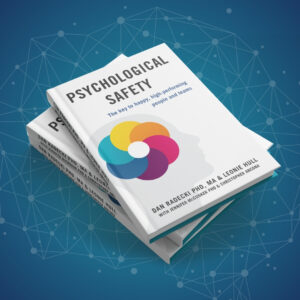Psychological Safety Book: The Key to Happy, High-Performing People & Teams
Both academic and industry research confirm that prioritizing psychological safety leads to measurable benefits—not just for personal well-being but also for workplace performance, engagement, and innovation.
We define Psychological Safety as:
The state in which one’s brain needs for security, autonomy, fairness, esteem and trust are met in a social context.
When this occurs, teams feel safe to take interpersonal risks without fear of humiliation or retaliation.
The Neuroscience Behind Psychological Safety
For years, organizations struggled to measure and implement psychological safety effectively. The missing link? The brain. Neuroscience has now unlocked groundbreaking insights, showing that:
- Psychological safety is crucial for mental and physical health, workplace engagement, and productivity.
- Our brains are wired to detect social threats, which can trigger stress and reduce cognitive performance.
As society has evolved, our brains have become highly attuned to psychological threats in social interactions—whether it’s a manager’s tone, a colleague’s behavior, or a company’s culture. Understanding how your brain processes psychological safety is essential to improving workplace dynamics and overall well-being.
Introducing the SAFETY™ Model
The SAFETY™ Model, grounded in neuroscience, provides a framework to understand and implement psychological safety in the workplace and beyond. This model identifies key social motivators that influence behavior, decision-making, and team performance.
A must-read psychological safety book, SAFETY™ is your guide to navigating crucial workplace scenarios, from onboarding and corporate restructures to brainstorming sessions and leadership development.
This revolutionary book answers pressing questions like:
- Why am I anxious and stressed at work?
- Why do I struggle with self-doubt or imposter syndrome?
- Why do I fear speaking up in meetings?
- How can I create a psychologically safe environment for my team?
- What practical steps can I take to improve workplace culture and collaboration?
With the right strategies, psychological safety can transform workplaces. If you’re looking for a comprehensive psychological safety book that blends neuroscience, leadership insights, and actionable solutions, SAFETY™ is your ultimate resource.
Buy The Book:
Authors

Dr Dan Radecki

Leonie Hull
Co-founder & CEO

Jennifer McCusker

